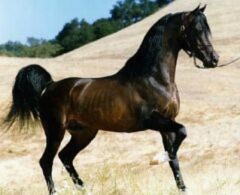In 1725, Nathan Harrison of Virginia imported the first Arabian stallion into the American colonies. In 1873, General Ulysses S. Grant was given two purebred
Arabian stallions, Leopard and Lindentree, on a trip to the Middle East by Sulton, Abdul Hamid II of Turkey. Leopard was then passed to Randolph Huntington, who then imported two more stallions and two mares in 1888 from England. This became the first purebred Arabian breeding program in the United States.

photo courtesy of Becky Sturdy
|
On September 2, 1908, the Arabian Horse Club of America, Inc. (now called the Arabian Horse Registry of America), was founded in New York State. It is now located in Colorado.
Arabian horses come in many colors, grey, chestnut, bay, roan, brown, and occasionally black. Most Arabians stand between 14.1 and 15.2 hands and weigh between 800 and 1,000 pounds as adults.
|